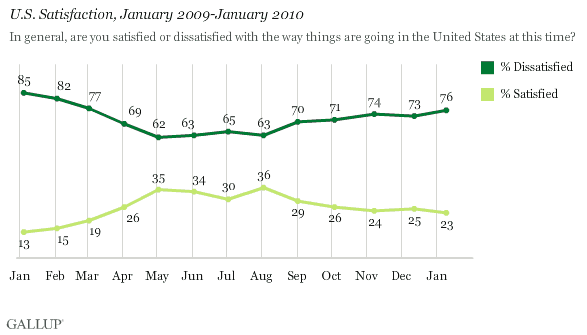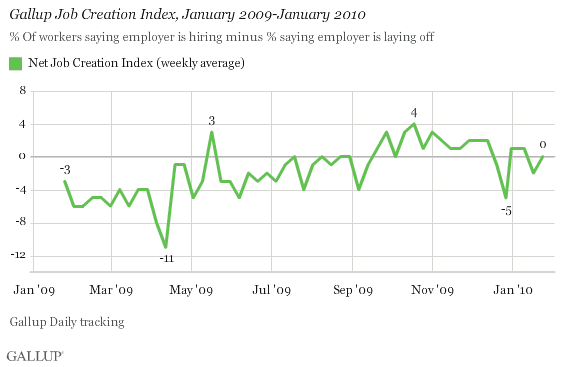PRINCETON, NJ -- Americans' opinions about the state of the nation have improved in several respects since President Barack Obama took office a year ago. Still, today's ratings are on the order of less bad rather than positive. Twenty-three percent of Americans are now satisfied with the way things are going in the country, up from 13% in early January 2009. However, 76% remain dissatisfied -- well above the average 57% dissatisfied since 1979.

Consumer attitudes about the economy show a similar pattern. Americans' confidence in the economy nearly collapsed during the Wall Street crisis in the fall of 2008, and has since rebounded some, but it remains profoundly negative.
At the start of Obama's term, Gallup's Economic Confidence Index registered -52; today it is -28. But the high point for this indicator over the past two decades was +56 in January 2000.

Additionally, while the year-to-year comparisons show some improvement in public optimism about the country and the economy, these levels actually peaked at various points in 2009, and have since declined. Hence, the recent momentum has not been in Obama's favor.
Americans are substantially less likely today to mention "the economy," generally, when asked what they think is the most important problem facing the country: 25% now name it, compared with 57% in January 2009. However, this decline is partially offset by an increase in the percentage citing unemployment or jobs -- currently 22%, up from 11%.
Another reason the economy may be less top-of-mind for Americans is that the healthcare reform effort in Washington has steered a segment of the populace toward that issue. Nearly one in five Americans (18%, including 24% of Democrats) name healthcare today as the nation's top problem, up sharply from 4% at the start of Obama's term.
The Gallup trend also documents slight increases over the past year in mentions of government/politicians, terrorism, and the federal budget deficit as the most important problem.

In line with Americans' increased focus on unemployment over the past year, Gallup's national Job Creation Index (based on the percentage of employed Americans saying their companies are hiring workers minus those saying their companies are laying workers off) suggests the job market is little better today than it was when Obama took office. The index for the most recent week (Jan. 18-24) stands at 0 (with equal percentages of workers saying their employers are expanding versus reducing their workforces), versus -3 for the comparable week in January 2009. Similarly, 9% of Americans today say now is a good time to find a quality job, compared with 13% in January 2009.

On a more personal level, Americans are slightly more upbeat about their own standard of living today than they were last January. The percentage of Americans now saying their standard of living is "getting better" exceeds the percentage "getting worse" by 9 points; this compares with a 0 score on the same index a year ago.

Bottom Line
In reviewing the state of the nation Wednesday night and charting his course for the coming year, President Obama can rightly point out real improvements in Americans' evaluations of the country and the economy since he took office. However, his deteriorating approval ratings -- dropping from 68% when he took office to 48% today -- are a meaningful indicator that those improvements fall well short of what Americans expected from him.
Survey Methods
Results are based on telephone interviews with 1,023 national adults, aged 18 and older, conducted Jan. 8-10, 2010. For results based on the total sample of national adults, one can say with 95% confidence that the maximum margin of sampling error is ±4 percentage points.
Interviews are conducted with respondents on land-line telephones (for respondents with a land-line telephone) and cellular phones (for respondents who are cell-phone only).
In addition to sampling error, question wording and practical difficulties in conducting surveys can introduce error or bias into the findings of public opinion polls.
